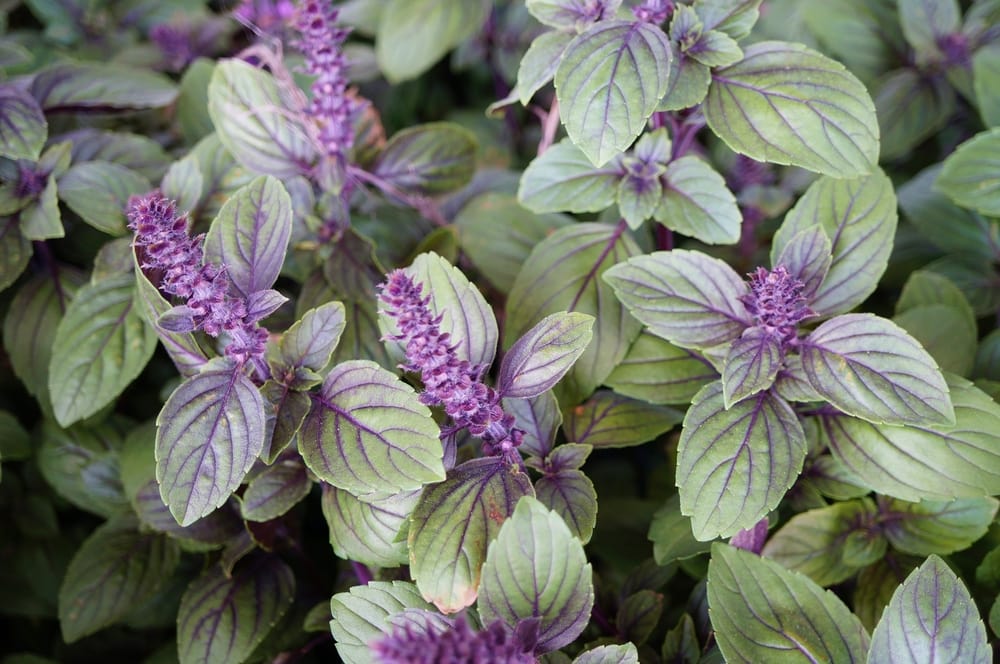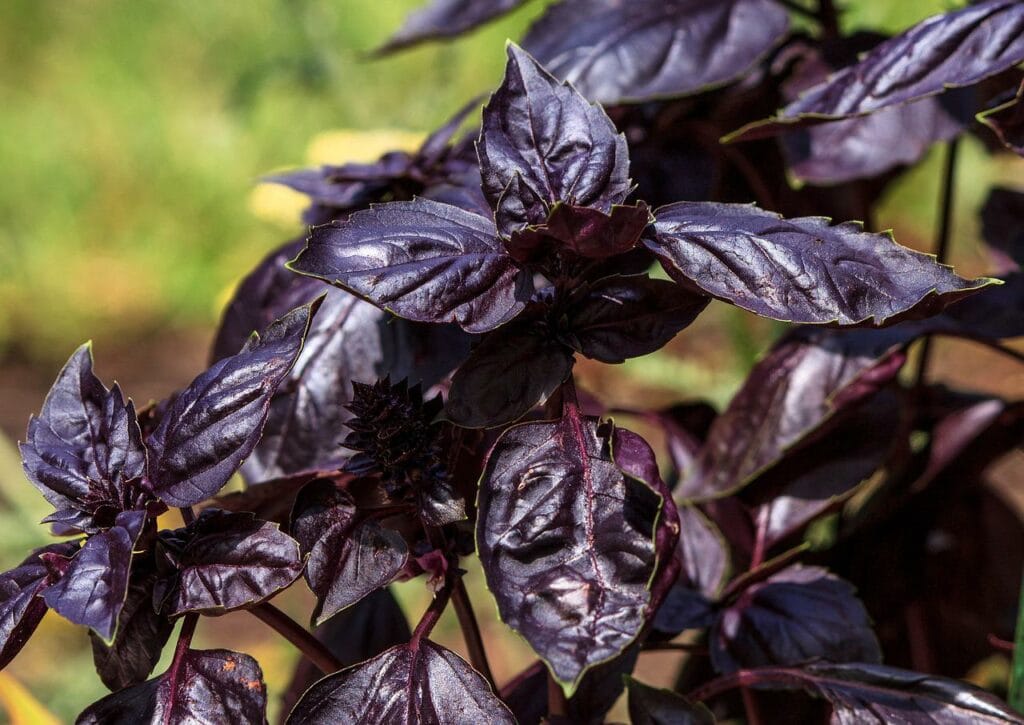8 Types of Basil to Grow at Home (With Pictures)
-
Pete Ortiz
- Last updated:

Basil is a remarkable herb with many health benefits, carrying antioxidants, vitamins, anti-bacterial properties, and essential oils. Besides being incredibly healthy and beneficial, this plant plays a crucial role in the culinary arts. One of the most potent flavors and fragrances you acquire from certain dishes comes from the basil plant. It is used worldwide for spicing up dishes like pasta, salads, and even certain drinks.
While you may believe basil comes in only one form, it has many varieties that offer a wide range of tastes. Certain basil types go well with specific meals, so knowing the most popular types of basil and the best way to utilize them is an excellent skill. Read the rest of this article to learn more about different basil varieties.
The 8 Types of Basil to Grow at Home
1. Thai Basil (Ocimum basilicum)

| Average size | 20–24 inches |
| Characteristics | Fragrant, mild licorice flavor |
| Common uses | Southeast Asian dishes, salads, curries, noodles, meat, fish, stir-fries |
Thai basil is an excellent ornamental plant for any garden or landscape, bringing uniqueness with its lovely green leaves and purple stems. They can grow to be between 1 and 2 feet high. Besides bringing a soothing and attractive appeal to your garden, this type of basil plays a considerable role in kitchens of Southeast Asia. Thai basil is an essential ingredient that brings a licorice or anise flavor to any dish, spicing up the meal and giving it a unique aroma. To keep using this plant, you can pinch the flowers as soon as they appear, making it as productive as possible.
2. Sweet Basil (Ocimum basilicum)

| Average size | 18–24 inches |
| Characteristics | Spicy, clove flavor |
| Common uses | Pesto sauce, salads, tomato sauce, pasta, pizza |
Sweet basil is the most common type of basil and a classic spice in many dishes. It grows rounded leaves with a spicy clove flavor, which many cooks adore adding to their meals. You can use sweet basil to make salads, tomato sauce, and pesto sauce since you can gather many leaves of this variety. To improve the growth of the sweet basil, it would be best to harvest the leaves often by pinching the stem or creating a clean cut with scissors or a knife.
3. African Blue (Ocimum kilimandscharicum x basilicum)

| Average size | 3 feet or taller |
| Characteristics | Strong, clove-like flavor |
| Common uses | Salads, sweet desserts, pesto, chimichurri sauce |
African Blue basil has distinctive green leaves with subtle purple veins. They can grow up to 3 feet or even taller. The African blue basil is one of the few perennial and sterile varieties, meaning that cuttings can only propagate them. This plant is excellent for salads and sweet desserts because of its strong flavor. Unlike other basil varieties, you should not pinch the African Blue basil to promote better growth. Instead, you should leave the plant as it is, and it will grow stunning, small blue flowers that attract bees.
4. Cinnamon (Ocimum basilicum)

| Average size | 18–30 inches tall |
| Characteristics | Spicy, fragrant aroma and flavor, reminiscent of cinnamon and mint |
| Common uses | Fruit salads, stir-fries, cocktails |
Cinnamon or the Mexican basil is easily recognizable by the unique fragrance of its foliage, which resembles that of cinnamon, hence the name. While cinnamon basil is mostly grown for its flavor and fragrance, it also has ornamental qualities and is loved by many gardeners. The leaves tend to be smaller than other types of basil and thanks to the bright purple stems and flowers, this basil will stand out amongst others in the garden. It is best used in salads, stir-fries, or your daily cup of tea to improve the taste.
5. Lemon Basil (Ocimum basilicum citriodorum)

| Average size | 18 inches |
| Characteristics | Intense fragrance and taste, reminiscent of citrus fruits |
| Common uses | Salads, cocktails, tea, fish, chicken |
Lemon and lime basil are unique for their strong citrus aroma and fragrance. This basil thrives in heat and can be grown in any garden, in containers, and pots. Some varieties of lemon basil can grow up to 18 inches high, with leaves larger than most other citrus-based basils. You can use this type of basil when spicing dishes, such as fish, chicken, and salads. Besides being widely used in meals, you can also use this herb in drinks such as cocktails, tea, lemonade, or even in making a regular glass of water more delicious.
6. Greek Basil (Ocimum basilicum minimum)

| Average size | 8 inches |
| Characteristics | Ornamental herb with strong flavor and aroma |
| Common uses | Pizza, pasta, tomato and pesto sauce, salads |
Greek basil, or Fine Leaf basil, is another example of a beautiful ornamental herb that can also be used to spice up many dishes and meals. This plant grows with round, dense foliage, creating a lovely look suitable for any garden or even for an indoor container. Even though the leaf itself is small, they have a strong basil fragrance and provide a fantastic flavor. Greek basil is the crucial ingredient in pizzas, pasta, and pesto sauces.
7. Genovese (Ocimum basilicum)

| Average size | 2 to 3 feet |
| Characteristics | Peppery and spicy aroma, with a minty clove-like flavor |
| Common uses | Caprese salad, pizza, pesto sauce, sandwiches |
Genovese basil is the classic Italian green basil. It is the best basil variety for making homemade pesto sauce. Genovese basil can grow to be 2 feet tall and 1 foot wide. The leaves are a deep green, and while the flowers are a stunning white shade, it is best to nip them as soon as they bloom. Leaving flowers on the plant can make the leaves bitter and demote productivity. The Genovese basil is excellent for salads, sandwiches, and pizzas.
8. Purple Basil (Ocimum basilicum purpurascens)

| Average size | 18 to 24 inches |
| Characteristics | Not as sweet as other varieties, strong anise-flavor |
| Common uses | Green salad, soup, pesto sauce, garnish, pasta, preserved in oil or vinegar |
The Purple basil variety is another very unique basil type, especially for its stunning appearance. Its beautiful purple foliage has won this basil many awards for beauty and flavor. While the leaves are a deep shade of purple, they have a coppery glow. Even though it is very easy to cultivate this type of basil, it is crucial to plant them at the right time—two weeks after the last spring frost. Purple basil contains many minerals, vitamins, fibers and other nutrients. You can use the purple basil in many different dishes, such as in pesto sauce, salad, pasta, garnish, and preserved in oil or vinegar.
Conclusion
After reading this article, you will quickly learn the best possible varieties of basil you can effortlessly grow from the comfort of your home. There is no better feeling than waking up in the morning and gathering fresh basil leaves that leave a strong, gorgeous fragrance throughout your entire home.
See also:
- 7 Companion Plants for Basil (with Pictures)
- What Is the State Tree of Illinois? History, Facts, & FAQ
Featured Image Credit: tookapic, Pixabay
Contents


